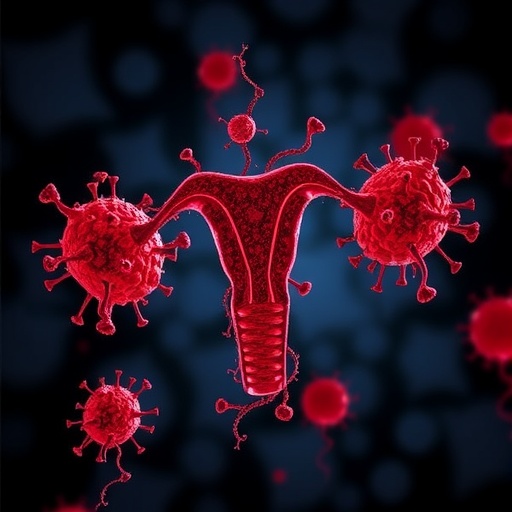In an unprecedented move within the realm of reproductive health research, a groundbreaking study published in the Journal of Ovarian Research has unveiled a novel approach to differentiate between premature ovarian insufficiency (POI) and menopause. This research, conducted by a team of scientists led by S. Maham and including notable researchers such as J.H. Kang and I. Kahttana, has identified distinct microRNAs found in urinary exosomes as reliable biomarkers. These microRNAs play a pivotal role in unraveling the complex biological processes underlying ovarian function and aging.
The phenomenon of premature ovarian insufficiency, characterized by an earlier-than-expected decline in ovarian function, poses significant health challenges for affected women. The implications of this condition extend beyond reproductive capabilities, with associated risks for cardiovascular health, osteoporosis, and psychological wellbeing. Conventional methods of diagnosis largely revolve around hormonal assessments, which can sometimes be ambiguous, consequently leaving many women without reliable information about their reproductive status.
The urinary exosomes referenced in the study are nanoscale extracellular vesicles that encapsulate a variety of biological molecules, including microRNAs. These exosomes have garnered interest within the scientific community due to their stability in urine and their potential in delivering critical insights about underlying physiological conditions. MicroRNAs, which are small non-coding RNAs involved in the regulation of gene expression, hold the keys to unlocking the biological mysteries related to ovarian aging.
In the study published under the title “Distinct urinary exosomal microRNAs as biomarkers for differentiating premature ovarian insufficiency and menopause,” researchers carefully collected urine samples from women diagnosed with POI and those who had naturally entered menopause. Through advanced profiling techniques, the researchers identified specific microRNA signatures that were significantly different between the two groups. The presence of unique microRNA profiles not only aids in distinguishing between POI and menopause but also stands as a testament to the intricate molecular changes that characterize these conditions.
The implications of this research are profound. By utilizing a non-invasive testing method, healthcare providers can enhance diagnostic accuracy, ultimately leading to more tailored approaches to treatment and management. For women experiencing symptoms related to ovarian function, such as hot flashes, mood swings, and irregular menstrual cycles, these findings provide a clearer path toward understanding their reproductive health. Early diagnosis could pave the way for timely interventions that can mitigate long-term health risks.
Moreover, the study aligns with a broader movement within medical research that seeks to shift the paradigm from reactive healthcare to proactive management of health issues. As diagnostic technologies evolve, the potential to identify biomarkers that elucidate complex reproductive health issues becomes increasingly feasible. The use of urinary exosomes represents a promising frontier in this endeavor, demonstrating how the tiny particles shed by cells can offer big insights regarding a woman’s health.
In practical terms, the research team’s findings could have immediate applications in clinical settings. Physicians may incorporate urinary microRNA testing as part of the evaluation process for women displaying early signs of ovarian insufficiency. Given that POI affects approximately 1% of women under the age of 40, the ability to confidently diagnose this condition could revolutionize care pathways for young women facing fertility challenges.
Additionally, by differentiating POI from menopause, the study contributes to reducing the stigma often associated with early menopause. Women diagnosed with POI frequently report feelings of isolation and confusion, exacerbated by societal misconceptions about aging and female reproductive health. By understanding the biological nuances that separate these two conditions, healthcare providers can foster a more supportive environment for affected women, acknowledging their unique challenges.
As researchers continue to explore the implications of these findings, the potential for future studies is expansive. The introduction of urinary biomarker profiles could extend beyond fertility issues, influencing research into other reproductive health disorders as well. In a future where personalized medicine becomes the standard rather than the exception, the role of microRNAs may become central in guiding clinical decisions and shaping treatment plans.
The research team’s dedication to unraveling the complexities of female reproductive health serves as a potent reminder of the importance of investing in scientific inquiry. With continued support and funding, the drive toward unlocking new biomarkers holds the promise of ushering in an era of innovative treatments and enhanced understanding of women’s health conditions. As these findings make their way into practice, they are likely to spark further interest and research efforts into microRNAs and their roles in reproductive health.
As the scientific community prepares to digest this study’s findings, it is clear that the intersection of molecular biology and clinical practice holds significant promise for the future. As we anticipate continued advancements in this area of research, the prospects for women’s health appear brighter than ever. With reliable and less invasive diagnostic tools, the goal of ensuring optimal reproductive health for women throughout their lifespan is more attainable than previously imagined.
In summary, Maham and colleagues’ exploration of urinary exosomal microRNAs not only enhances our understanding of premature ovarian insufficiency and menopause but also exemplifies a paradigm shift in diagnostic methods in reproductive health. This innovative research sets the stage for a future where women can receive more informed, timely, and personalized care regarding their reproductive health decisions.
Subject of Research: Distinct urinary exosomal microRNAs as biomarkers for differentiating premature ovarian insufficiency and menopause.
Article Title: Distinct urinary exosomal microRNAs as biomarkers for differentiating premature ovarian insufficiency and menopause.
Article References:
Maham, S., Kang, J.H., Kahttana, I. et al. Distinct urinary exosomal microRNAs as biomarkers for differentiating premature ovarian insufficiency and menopause. J Ovarian Res 18, 263 (2025). https://doi.org/10.1186/s13048-025-01823-y
Image Credits: AI Generated
DOI: https://doi.org/10.1186/s13048-025-01823-y
Keywords: urinary exosomes, microRNAs, premature ovarian insufficiency, menopause, biomarkers, reproductive health.
Tags: cardiovascular risks of POIhormonal assessment limitationsJournal of Ovarian Research findingsmenopause differentiation researchmicroRNAs and agingmicroRNAs in ovarian functionnovel diagnostic approaches in gynecologyosteoporosis and reproductive healthpremature ovarian insufficiency biomarkerspsychological effects of ovarian insufficiencyS. Maham research contributionsurinary exosomes in reproductive health





